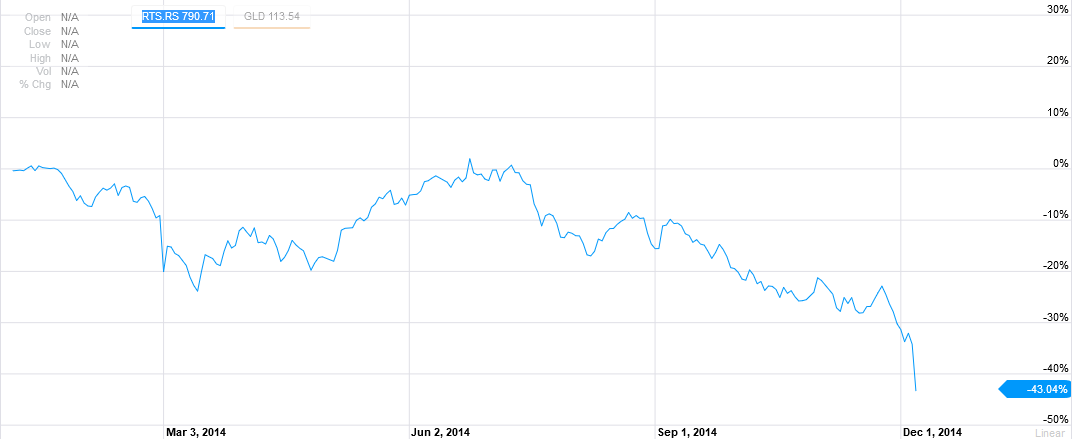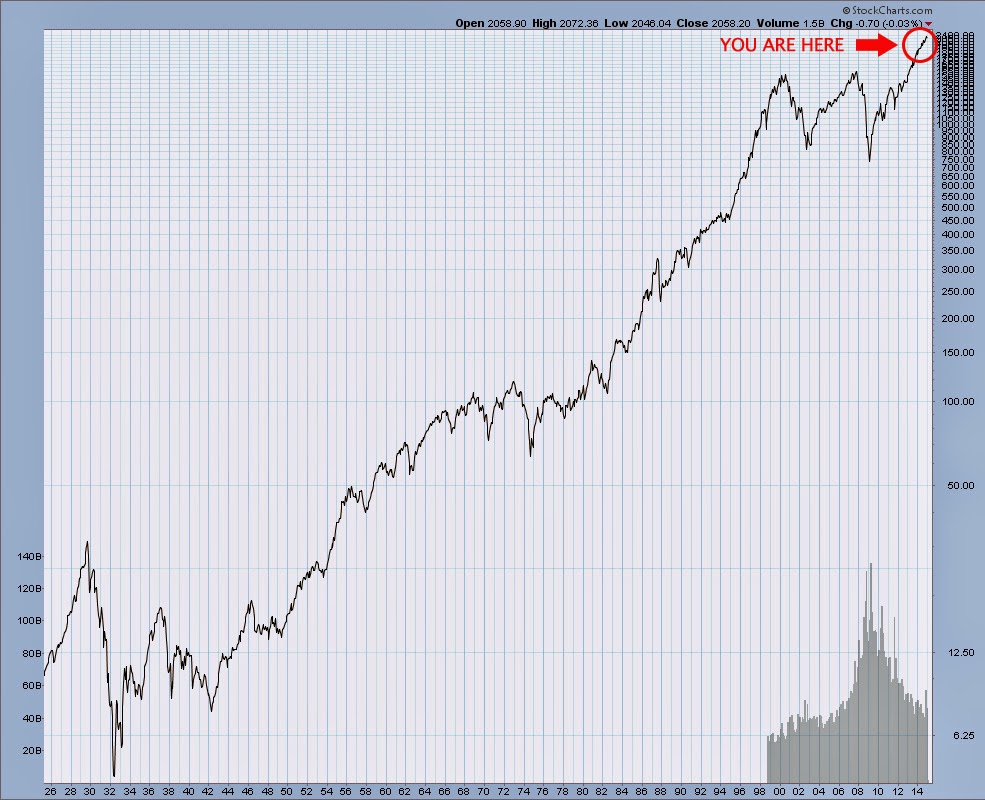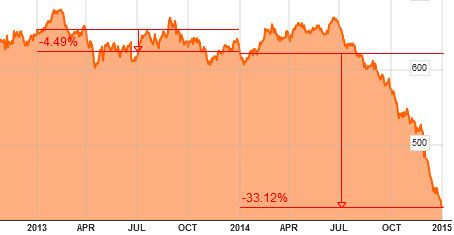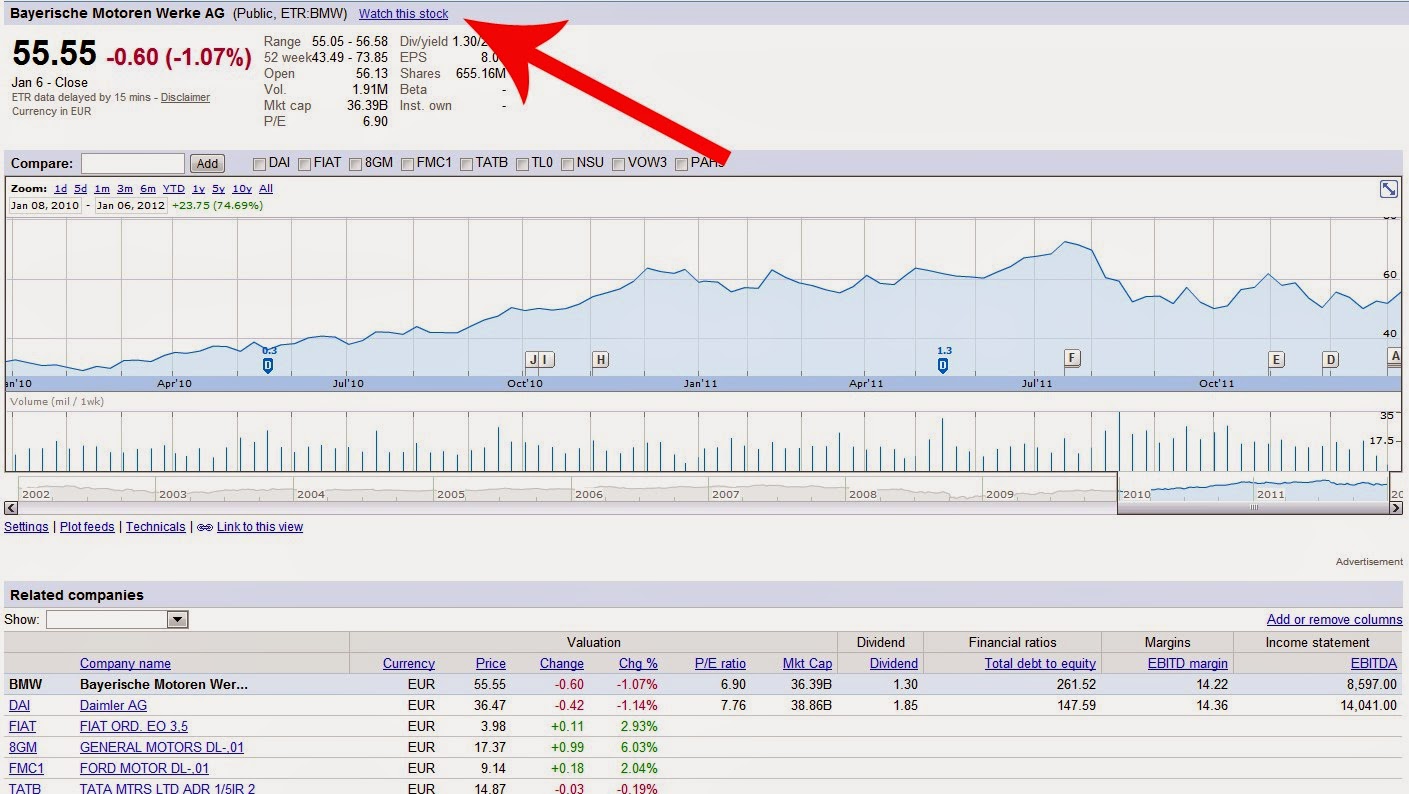Dit document heb ik ooit geschreven voor een goede kennis met interesse in de aandelenmarkten. Het vormt een basale inleiding om de aandelenmarkten in al haar mysticiteit tastbaarder te maken. Principieel moet ik elke blootstelling aan de aandelenmarkten afraden vanwege de omvangrijke risico’s. Er zijn veel specialisten die goede aanbevelingen kunnen doen omtrent jouw vermogensplanning. Wanneer je echter jouw nieuwsgierigheid niet bedwingen kunt, is de onderstaande aanpak een veilige manier om jouw investeringskeuzes te testen aan de marktrealiteit. Deze simulatie, bekend als
paper trading kan simpel worden uitgevoerd zonder lastige oefenaccounts of een aanmelding bij een broker. Dit geeft rust en bespaart hijgende telefoontjes om die eerste storting…
Mijn Beleggingsfilosofie
Beleggen kan op talloze manieren, met een veelvoud aan
instrumenten en intensiteit. De perfecte methodologie is een afweging van
talloze parameters en hoort te groeien met jouw persoonlijkheid en ervaring. Waarschijnlijk
vormt jouw beleggingshorizon de allerbelangrijkste overweging. Met andere
woorden, wanneer wil je winsten nemen en op welke frequentie wil je handelen? Ben
je op zoek naar vermogensbescherming? Of wil je bijverdienen? Bij een passieve
belegginswijze past een langere horizon, terwijl de spanne doorgaans verkort
naarmate de houding actiever wordt. Mijn voorkeur gaat uit naar de lange termijn
en ik bezie beleggingsbeslissingen graag in lijn met meerjaren-trends. Ieder
ander - en zeker beginners - zou ik eenzelfde lange horizon aanbevelen, al is
het om niet verloren te raken in de waan (koersen) van de dag. Een strategisch belegger
met een lange horizon gebruikt een beurscrash om bij te kopen, waar een
korte-termijn belegger veel geld ziet verdampen tijdens beurscrashes. Het
rendementspotentieel is moeilijker te becijferen. Al decennia struikelen
academici, experts, beleggers en handelaren welk tijdsraam het meeste rendement
oplevert. Het gros roept dat buy-and-hold
dood is en vele transacties per jaar lucratiever zijn. Echter laat Warren
Buffet het actieve handelen over aan adrenalinejunks en bouwt gestaag en
duurzaam aan zijn portefeuille, waarin hij zelfs nog posities heeft uit zijn
beginjaren (30+ jaar). De ultieme portefeuille heeft een gewogen risico-/rendementsverhouding,
welke zijn afgestemd op de persoonlijkheid (bloeddruk en levensfase) van de
belegger. De defensieve belegger kiest voor veilig en duurzaam, terwijl de
offensieve belegger kiest voor een risicovoller en kortstondigere jacht naar
hogere rendementen. Natuurlijk loopt de defensieve belegger met een ‘veilig’ en
gestaag appreciërende Unilever het volledige risico wanneer het bedrijf
failliet gaat.
De Juiste Belegging
Professionals stellen doorgaans brede portefeuilles samen
rondom specifieke thema’s, met specifieke methodieken en doelstellingen. Binnen
deze portefeuilles zullen de fondsbeheerders diverse beleggingsinstrumenten
gebruiken voor een blootstelling aan de gewenste activaklassen en geografie. Een
activaklasse (‘asset class’) staat voor de productfamilie waarin wordt belegd (vb.
vastgoed of aandelen). De som van alle mogelijke investeringsinstrumenten heet effecten
(‘securities’). Voor dit document kijk ik naar de activaklasse aandelen (‘equities’
of ’stocks’). Aandelen hebben normaliter betrekking op bedrijven. Weet dat bedrijven
voor het aantrekken en renumereren van extern kapitaal separate fondsen oprichten.
Derhalve zoek je technisch gezien het fonds Ahold N.V. en niet de rechtspersoon
Ahold (Zaandam) B.V.
Portefeuillebeheer
Het beheer van de beleggingsportefeuille is wellicht het
allerbelangrijkste voor een renderende toekomst. Ik durf zelfs te beweren dat
ieder die faalt, dit doet vanwege slechte portfoliomanagement en niet zozeer
vanwege slechte beleggingen an sich. Een portefeuille met louter rijzende
sterren kan, onder slecht beheer, leiden tot persoonlijk faillissement. Terwijl
deze twee jaar later mooie rendementen hadden kunnen opleveren. Dus als jij
faalt, doe je dit omdat je jouw ‘zetten’ niet goed beheerst (in relatie tot je
marge). Vaak hoeven we slechts de cyclus, of de dip uit te (kunnen) zitten om
hogere toppen tegemoet te zien. Ik zal alle complexiteit besparen, maar wil
graag aandacht vestigen op regel #1 binnen portfoliomanagement; diversificatie.
En diversificatie kenmerkt zich door non-correlatie. Dit betekent dat de
diverse effecten binnen de portefeuille een historische neiging moeten hebben
tot ongelijke piek-dal momenten. Het precies tegenovergesteld bewegen van 2 effecten,
duid op negatieve correlatie (-1) en is nog steeds correlatie. Een gezonde
portefeuille is gediversifieerd in meerdere dimensies, met spreiding over
activaklassen, geografische marktbediening, sectoren, bedrijfsomvang en meer. Een
wijde spreiding binnen je portefeuille zet bij neergaande koersen niet je
gehele portefeuille onder water (gedwongen noodverkopen door afgewaardeerd onderpand=’margin
call’). Als het goed is valt er in alle 4-seizoenen zowel te oogsten als te
zaaien.
De Beurs en het Aandeel
Elk beursgenoteerd bedrijf heeft een aandeelhoudersverplichting
en zal op haar corporate websites (investor relations) informatie richting
investeerders verschaffen. Bekijk deze secties en zorg dat je de relevante
informatie uitspit om een goede beleggingscase te formuleren. Ongeacht welke
informatie jij belangrijk vindt, zorg tenminste en te allen tijde dat je de
PROSPECTUS hebt gelezen! En als er geen prospectus is, kies dan voor een andere
belegging.
Koersinfo & notering @ bmwgroup.com > Investor Relations
Exact dezelfde aandelen kunnen genoteerd staan aan
verschillende beurzen (‘exchanges’). Door tijdelijke en lokale
handelsfluctuaties kunnen op verschillende beurzen geringe prijsverschillen
ontstaan. De markt zorgt in de regel voor het gelijktrekken van deze
fluctuaties (‘arbitrage’). Zowat elk ontwikkeld land heeft één of meerdere
beurzen, welke fysieke, virtuele of hybride handel kennen. De meeste van ons kennen
Nasdaq (technologie georiënteerd), het welbekende New York Stock Exchange of
onze hoogsteigen Amsterdam Stock Exchange (de oudste beurs ter wereld). Niet
elke beurs heeft dezelfde betrouwbaarheid en liquiditeit, welke direct invloed
kunnen hebben op hoe jouw order uitgevoerd wordt.
Aandeelinformatie @ bmwgroup.com > Investor Relations
Veel bedrijven hebben meerdere soorten aandelen, elk met
eigen identificatiecodes (‘ticker codes’). De beurs van thuisland biedt vaak de
hoofdnotering (‘primary exchange’). Hier is de handel veelal het meest liquide,
hetgeen gunstig is voor de aan-/verkoopbaarheid alsook de spread (verschil
bied-laatprijs). Moderne handelsplatformen dirigeren orders automatisch naar de
beurs met de gunstigste condities.
Marktdata
Bloomberg (VS) en Reuters (Europa) zijn de marktstandaard
betreft informatieverschaffing binnen de financiële wereld. Zij bieden specialistische
gereedschappen aan professionele marktpartijen en vormen een goed vertrekpunt
voor de thuisbelegger (‘retail investor’).
Zoek direct op bedrijfsnaam of op ticker symbol. In sommige
gevallen is koersdata beschikbaar over het aandeel op meerdere beurzen. Het
meest complete beeld kan vaak gewonnen worden door de bovenste optie te
selecteren.
Effecten selectiescherm @ Reuters.com
Het goed inspecteren van deze sites op jouw
voorkeursbedrijven is werkelijk een must. Klik rond en kijk wat jij belangrijk
zou kunnen vinden (en leer).
Aandeleninformatie @ Reuters.com
Fundamentele Analyse
Het nauwgezet onderzoek naar de (financiële) onderbouwing van
markt en bedrijf staat bekend als Fundamentele Analyse. Deze analysevorm dient
inzicht te verschaffen in het vermogen van een bedrijf om waarde te vangen, te
leveren en af te zetten. Deze analyse richt zich derhalve op het bedrijf
(aanbodzijde), met als doel om onderbenutte intrinsieke waarde bloot te leggen,
maar ook op de markt als geheel (vraagzijde). Vervolgens moeten verkregen
inzichten op realistische wijze worden geëxtrapoleerd naar de toekomst, met een
gevoel voor marktontwikkeling, danwel consumententrends. Fundamentele Analyse
is omvangrijk, maar evenzo belangrijk. Het uitvoeren van de goede fundamentele
analyse en het wegen van de juiste metrieken mag jouw eerste stap naar zelfstudie
zijn.
Om je voort te helpen, kunnen we deze stelregels van meester
Buffet in ogenschouw nemen;
- Wees de directeur van het bedrijf dat je analyseert en leer JOUW bedrijf kennen (nauwgezetheid).
- Overtuigd jezelf van het bedrijf en toekomstperspectieven in die mate dat je zelfs bereid zou zijn om jouw laatste € in het bedrijf te steken. (overtuiging)
- Een goede belegger (‘investor’) houdt niet van onzekerheden. (realisme)
Technische Analyse
De fundamentele analyse heeft inzicht verschaft in onderbenutte
waarde in het verdienmodel c.q.
bedrijf. Daarna volgt de technische analyse om (een) verstandig(e) instapmoment(en)
te bepalen. We gaan naar de grafieken kijken, met andere woorden de prijs van het effect. Onthoudt dat
waarde versloten ligt in het bedrijf, terwijl de prijs slechts in de hoofden
van de observatoren (de markt) bestaat.
Welnu, tijd voor actie. Ik zal aan de hand van aandelen
enkele voorbeelden doorlopen, zodat je vervolgens in Google Finance een
fictieve portefeuille kunt opbouwen. Het samenstellen van een portefeuille kan met
diverse tools, echter prefereer ik Google. De interface is licht/snel, het
overzicht is goed, het combineert handig met het Google Account en het brengt
mij een goed overzicht van relevant en actueel nieuws rondom de betreffende
aandelen.
Google Finance
Vul in het zoekveld de bedrijfsnaam of de ticker symbol in. Google
Finance registreert maar een beperkt aantal beurzen, ETR staat in dit geval
voor de XETRA, welke de handelsplaats is van de Frankfurt Stock Exchange (hoofdnotering).
Zoek Aandeel @ Google Finance
Indicatoren en Visuele Analyse
Vanuit de Technische Analyse kijk je louter naar koersen. Deze
discipline beschouwd huidige marktprijs als de som van al het beschikbare nieuws
en marktdynamiek. Dit is natuurlijk een voortschrijdend verhaal (lees: koersverloop).
Begin ALTIJD vanuit het langetermijnbeeld voor overzicht over het strijdveld en
het relativeren van de huidige marktprijs. Visuele analyse is één. Vervolgens
maken Technisch Analisten veelvuldig gebruik van technische indicatoren. Als
voorbeeld raad ik je aan om onder de grafiek ‘technicals’ aan de te klikken en
EMA(200) te activeren. Dit is het lange-termijn (200-daags) slepend gemiddelde,
welke ik bezie als een soort ‘fair value’. Duikelen we onder dit gemiddelde,
beschouw ik het effect als ‘goedkoop’ en een beweging boven het gemiddelde
beschouw ik als ‘duur’. Daarnaast verklappen koersbewegingen onder deze
hulplijn een dalende trend en koersbewegingen erboven onthullen een stijgende
trend. Begrijp dat dit niets zegt over de (on)aantrekkelijkheid van een
aandeel. Immers had een koop in 2010, boven de EMA(200), over de jaren zeer
lucratief kunnen zijn. Klik eens wat rond en ga zelf het experiment (en
zelfstudie) aan.

Voeg Technische Indicator toe @ Google Finance
Enkele tips vooraleer je het in-/uitstapmoment bepaald:
- De trend (stijgend/dalend) is wat altijd wat het is, totdat het tegendeel bewezen is.
- Een markt die niet stijgt, daalt.
- Markten kunnen voor aanzienlijke tijd over- of onderprijst blijven.
- Bevecht al jouw aannames. En de aanname onder deze aannames.
- Wees berekend op jouw ongelijk.
En ja, deze tips klinken als peuterwijsheid. Maar er komt
een dag dat je terugdenkt aan wat hier geschreven staat…
Bouw Jouw Portefeuille
Speel, kijk en vergelijk. Wat zijn de historische
aandelenkoersen, hoe hoog is het dividend en hoe verhoudt dit bedrijf zich tot
branchegenoten? Vergeet het nieuws niet te bekijken/bij te houden. Wanneer je
dit bedrijf wilt toevoegen aan je watchlist kies je Watch this stock.
Assembleer jouw shortlist @ Google Finance
Onder My Portfolio
bevindt zich de persoonlijke watchlist, voor een snel overzicht van alle, als
interessant gemarkeerde effecten. Deze watchlist bouw je gemakkelijk om tot een
volwaardige beleggingsportefeuille, door het toevoegen van transacties.
Portefeuille Transacties en Prestaties @ Google Finance
- Hier vind je de resultaten van de geselecteerde aandelen, al dan niet met persoonlijke winst-/verlies gegevens (alleen indien er transacties zijn toegevoegd).
- Hier kun je transacties toevoegen, ook in het verleden.
- Vergeet niet om de valuta op de €uro te zetten
Belangrijke Toevoegingen
Valutarisico
Indien je aandelen op buitenlandse beurzen koopt, reken je
deze ook af in de valuta in kwestie. Deze valutatransacties gaan gepaard met
variaties in euro/dollar-koers. Tevens kunnen voor deze muntconversie extra
transactiekosten gerekend worden. Ook zal er, indien er nog geen Dollars in
bezit waren, automatisch een rentedragende lening gesloten worden.
Transactiekosten
De transactiekosten moeten ook meegenomen worden (en kunnen
in Google Finance worden toegevoegd). Bereken de kosten op basis van commissie
over de totale transactiewaarde.
Kopen is 1 transactie,
maar verkopen (voor winstnemingen) is nog 1 transactie...
Margin Account
Rood staan kost geld. Met een klein beetje gemak handel je
al onder hefboom. Dit speelt niet mee in je Google-account, maar wel in een echte
omgeving. Het hiermee omgaan voegt een hele nieuwe dimensie aan het
(portefeuille)beheer toe. Wanneer de onderpand zakt, is een groter component
van jouw dekking onder nieuwe aankopen ingeleend (vreemd vermogen). Wanneer je echt gaat beleggen is het van vitaal belang dit mechanisme goed te begrijpen, of absoluut NIET met hefboom ('on margin') te handelen.
Oh, en mocht je initieel succes boeken (waarschijnlijk geluk
en omdat de koers is gestegen om redenen die jij echt niet doorziet) en de Tony
Montana in jou de overhand neemt;
Behaalde resultaten uit het verleden, bieden geen garantie
voor de toekomst.
Enkele links
Investopedia is een waardevolle bron voor kennisverbreding omtrent beleggen. Zij bieden een simulator in een gesloten omgeving, waar je een gevoel kunt krijgen voor handel MET een beperkte portemonnaie. Ik heb geen ervaring met de tool, maar het kan interessant zijn.
Alle in dit document genoemde voorbeelden vormen geen
beleggingsadvies. De specifieke voorbeelden zijn louter bedoeld ter
illustratie.































